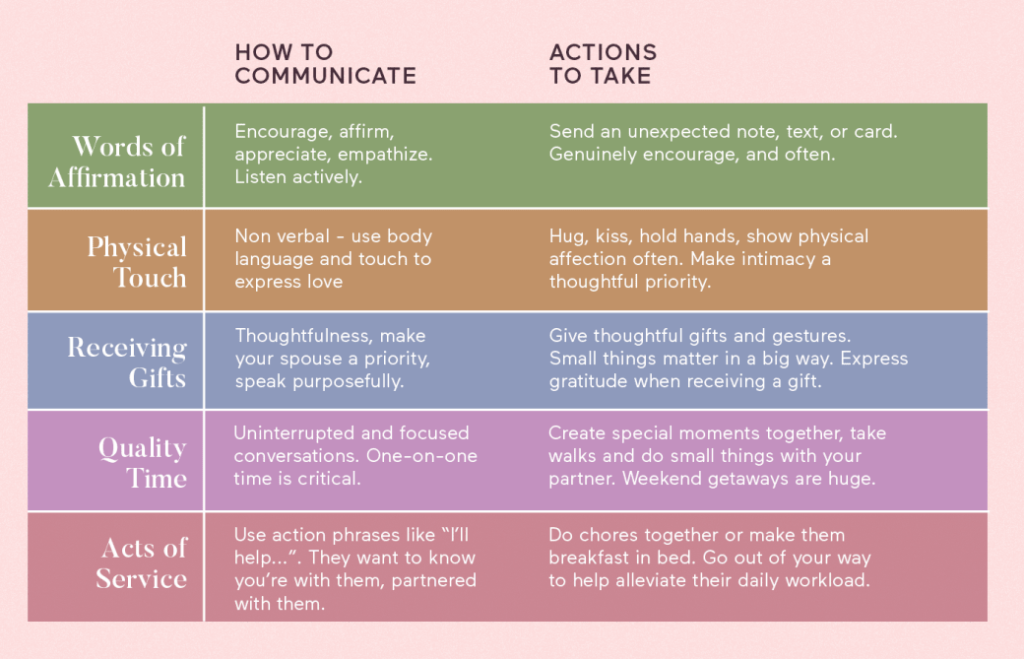By Rania Tsoli,
Since the beginning of time, there have been various notions that have deeply enchanted humans. Life and death, potential divine powers and spirits, our riddling existence, and the mysteries that lay in our vast universe; alongside them, the enigma of how the heart and soul work has always mesmerized us. Philosophers and psychologists have tried to explain the nature of our emotions, and people of the arts have earnestly proclaimed their beauty for centuries; the ways we perceive and express feelings are truly fascinating. Many times, we might feel more comfortable with showing our love and gratitude in different manners than others, sort of like speaking a different language, one might say – or is it exactly like that? Let us explore the theory and practice of the five love languages and see how they can prove to be not only interesting, but also helpful when it comes to understanding and communicating with our partners.
The concept of the five love languages was developed by author, pastor, and counselor Dr. Gary Chapman, and it describes the ways that people receive and express love in their relationships. Despite the fact that Chapman’s book, The 5 Love Languages, was initially released in 1992, it continues to benefit people today, having sold more than 12 million copies since then. To share a basic backstory, before coming up with the theory and writing the book, Dr. Chapman spent years taking notes with couples he was counseling when he began recognizing some patterns. He began to notice that couples frequently misunderstood one another’s requirements, and after reviewing his notes, he determined that there appear to be five fundamental ways of transmitting ideas and feelings that individuals react to, or five main “love languages,” as he decided to call them.
The five love languages, as we know them today, are words of affirmation, quality time, acts of service, physical touch, and receiving gifts – and, based on the responses of 10,000 people who took the online quiz on Chapman’s website in 2010, words of affirmation are the most common primary love language, though by a small margin. Typically, people who feel comfortable with this love language value expressing and receiving feelings through verbal acknowledgments – words of affirmation are all about showing affection through spoken words, appreciation, and praise. To get a sense of words of affirmation in action – and thus, understand your partner on a deeper level if this is their primary love language – the following are perfect examples: handwritten notes, heartfelt compliments, tender “I love you’s”, and kind words of support and appreciation, as well as frequent digital communication, like texting and social media engagement.

The second love language is quality time. People with this love language feel most adored when their partner actively wants to spend time with them, and particularly love when listening to them, eye contact, and full presence are prioritized hallmarks in the relationship; it is all about giving your undivided attention to that one special person, without the distraction of television, phone screens, or any other outside interference. While sometimes difficult to cultivate given all of the distractions around us, there are plenty of ways, both big and small, to find some one-on-one time and honor this love language: a moment of intense connection, meaningful conversations with focused eye contact, sharing recreational activities, or a planned, private getaway; anything that fosters active and intentional time to connect is strongly desired and deeply appreciated.
Third on the list is the love language of acts of service. This language consists of doing things for your partner, most often in an attempt to make their lives easier or to brighten up their day, even if it sometimes means having to go out of your way. The people that “speak” this love language adore it when their partner does little things for them and can often be found doing things in return. It is things like making you soup when you are sick and coffee when you are sleepy, bringing you a treat to eat just because, giving you a ride somewhere without needing to be asked, or running some errands when you have had a hard day: actions like these go a long way, and these people naturally enjoy both sharing as well as accepting love in this particular form.
After acts of service, there comes physical touch. People with this love language feel loved when they receive physical signs of love and affection, including actions like kissing, handholding, hugging, and sex, and usually express their emotions most comfortably in the same way, as well. When individuals express their gratitude using this language, it may be extremely affirming and serve as a powerful emotional bond for those who consent to it. It is important to remember that physical touch encompasses so much more than sexual intimacy: from a mere moment of playing with your partner’s hair, a soft, tender kiss and a simple, loving touch to a big hug, frequent handholding and cuddling, any form of physical contact means a lot to those that naturally show their affection in this manner.

The fifth of the love languages is receiving gifts. As the name implies, this is the love language of gift-giving – but do not stress! A gift’s worth is not typically attached to a price tag here. A common misconception of this love language is that the gift must have a monetary value but, in reality, it is all about the perceived value in terms of thoughtfulness. What matters to those that “speak” this love language is the symbolism of affection behind the gifts, and the emotions they invoke; by getting a present, they feel really seen and valued, and they usually enjoy making their partner feel the same way by giving them presents as well, no matter how small or big, simple or extravagant. A gift can have a big impact on them, and they treasure not only the gift but also the time and effort the gift-giver put into it.
Of course, it is extremely common for the way that someone expresses their emotions to depend on gender, culture, customs, and values, as well as past experiences and their psychological background – nonetheless, Dr. Chapman’s work certainly makes things easier. The five love languages provide an interesting and helpful point of view, which can help us understand our partners’ needs and strengthen our relationships – and, although Chapman focuses on romantic relationships, the five love languages can surely help in other types of relationships, as well: to know a friend’s or relative’s emotional needs and how they like expressing their feelings is just as important as knowing those of a romantic partner.
You might enjoy ignoring your phone and going out for a fun activity with your loved one, or you might like loading the dishwasher for them after they cooked for you. You might feel like giving them a hug after receiving a kiss on the forehead, or maybe you love seeing their face light up when you hand them a gift, just like yours does when they do the same thing for you. Maybe you like complimenting them, or you might make sure to text them throughout the day, just to see what they are up to; it does not matter how you say it, or if you actually say it out loud. There might be five love languages, and, once in a while, some translation might be needed; but when it comes to love, some things are crystal clear. Feelings do not always have to be complicated: just communicate, appreciate, and – most importantly – have fun!
References
- What Are The 5 Love Languages? Everything You Need To Know, mindbodygreen.com, Available here
- What Are the Five Love Languages?, verywellmind.com, Available here
- What Are the Five Love Languages?, brides.com, Available here




